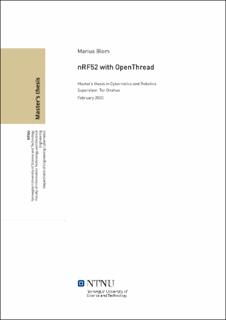| dc.contributor.advisor | Onshus, Tor | |
| dc.contributor.author | Blom, Marius | |
| dc.date.accessioned | 2020-06-06T16:00:25Z | |
| dc.date.available | 2020-06-06T16:00:25Z | |
| dc.date.issued | 2020 | |
| dc.identifier.uri | https://hdl.handle.net/11250/2657062 | |
| dc.description.abstract | Formålet med oppgaven var å fortsette med jobben Grindvik hadde gjort når det kommer til å skrive om Java applikasjonen til C++. Denne oppgaven inkluderte også jobben med å bruke en NRF robot for å kommunisere med den nye C++ applikasjonen ved å implementere ny maskinvare til roboten. Dette krever også å implementere Thread for lokalt nettverk for å bruke med roboter, sette opp en grense router for å videresende informasjon i hvilken som helst retning til et ekstern nettverk og implementere en MQTT-SN inngangsport for å kommunisere med en MQTT megler.
NRF krever at det blir satt opp et Thread nettverk ved å bruke den åpne kildekode implementasjonen OpenThread for å kunne kommunisere med C++ applikasjonen. En Raspberry PI ble satt opp som å fungere som en grense router, og som en MQTT-SN inngangsport. Siden Raspberry PI mangler IEEE 802.15.4 standarden som brukes av Thread, så måtte en nRF52840-dongel bli koblet til og brukes som en nettverks ko-prosessor i applikasjonslaget.
NRF roboten hadde allerede programvare for å kommunisere med periferiutstyr gjennom
I2C protokollen, men manglet den nødvendige maskinvaren for å kommunisere med Thread. Kommunikasjonen på NRF roboten ble oppdatert fra å bruke Bluetooth Smart gjennom system-on-chip på roboten, i stedet ble det satt opp kommunikasjon gjennom MQTT protocollen ved å bruke en nRF52840-dongel via I2C.
C++ applikasjonen ble testet med en ekte robot ved å abonnere på emner fra en MQTT megler på nett. NRF roboten gjorde målinger med infrarøde sensorer, og publiserte til samme emne gjennom MQTT-SN inngangsporten som var satt opp på Raspberry PI.
Kildekoden i C++ applikasjonen ble ryddet opp i ved å flytte noen av funksjonalitetene fra main klassen over til egne respektive klasser. En ny funksjon ble laget i C++ applikasjonen der en ekte robot vil lese et koordinat par som C++ applikasjonen publiserer. Koordinat parene vil være relative til robotens nåværende posisjon i den ekte verden for å oppnå en implementasjon av en enkel navigasjon algoritme. | |
| dc.description.abstract | The purpose of this thesis was to continue the work done by Grindvik with rewriting the existing
Java server application to C++. This work also include using the NRF robot to communicate
with the new C++ application by adding new hardware to the robot, which requires implementing
Thread for a local network to use with the robots, setting up a border router to forward
information in any direction to an external network and implementing a MQTT-SN gateway for
communication with a MQTT broker.
For the NRF robot to be able to communicate with the C++ application, the Tread network
was set up by using OpenThread, which is the open-source implementation of Thread. A
Raspberry PI was set up to function as a border router and as a MQTT-SN gateway. Since the
Raspberry PI lack the IEEE 802.15.4 standard used by Thread, a nRF52840-dongle had to be
connected and set up to be used as the network co-processor in the application layer.
The NRF robot already had the software to communicate with peripherals with the I2C
protocol but lacked the necessary hardware to communicate via Thread. The communication
of the NRF robot was updated from using Bluetooth Smart via the system-on-chip and instead
were set up to communicate through the MQTT protocol by using a nRF52840-dongle via I2C.
The C++ application were tested with a real robot by subscribing to topics on an online
MQTT broker. The NRF robot would publish measurements made by the infrared sensors to
the same topic through the MQTT-SN gateway that is set up on the Raspberry PI and vice versa.
The code in the C++ application have been cleaned up by moving some of the functionalities
from the main class and into their own classes. A new function was made in the C++
application, where a real robot will read coordinate pairs published by the C++ application , the
coordinate pairs will be relative to the robots current position in the real-world to achieve an
implementation of a simple navigation algorithm. | |
| dc.language | eng | |
| dc.publisher | NTNU | |
| dc.title | nRF52 med OpenThread | |
| dc.type | Master thesis | |
